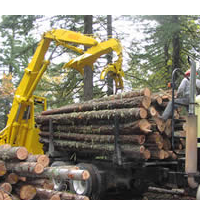Why are Georgia and North Carolina Selling their Forests to Create Energy in Europe and the UK?
 Trees cut for wood pellets (photo: Forest and Rangelands)
Trees cut for wood pellets (photo: Forest and Rangelands)
The short answer—that overseas utilities are buying the wood to burn in their power plants as a way to reduce greenhouse gas emissions—naturally raises the question of whether that is a good idea or not. As environmentalists try to block the growth of this transatlantic trade in American wood-fuel, others argue that wood-burning, like expanded use of natural gas, can be a temporary alternative to burning oil or coal until new technology allows a shift to zero or near-zero carbon emissions.
The wood-fuel trade, which will soon comprise millions of metric tons of American wood pellets, is driven by European Union (EU) rules mandating that 20% of Europe's energy should come from "renewable" sources as a way to combat climate change. As a form of “biomass,” i.e., material composed of living or recently alive organisms, usually plants, wood is a renewable source because trees can be grown and harvested like crops.
Environmentalists are focused on the effects of the trade on threats to the food supply and on global warming.
Typically, wood-fuel pellets are made from lumber plantation trees that have been thinned-out prior to achieving commercial maturity. Traditionally purchased by the pulp and paper industry, this low value wood is increasingly going to pellets for power stations in the United Kingdom. As demand increases, critics argue that the supply of such wood will be depleted, encouraging forest owners to use land currently planted with food crops or natural forests.
The issue regarding climate change has to do with the alleged carbon neutrality of burning biomass, including wood. The EU policy is based on the assumption that biomass energy is carbon neutral because the wood burned to generate electricity is replaced by living trees that absorb carbon dioxide.
Although that is true, it happens only over many years. Burning biomass releases up to twice as much CO2 as coal and up to four times as natural gas, and the time it takes for a replacement plant to absorb the compensating amount of CO2 is called the carbon payback.
Calculating carbon payback is complex. A report (“Dirtier Than Coal”) released in November 2012 by the UK's Royal Society for the Protection of Birds, Friends of the Earth and Greenpeace concludes that the payback period for electricity generated from whole conifer trees is 80 years, but a 2012 report by the Southern Environmental Law Center came up with a 35-50-year payback period for wood generally.
Meanwhile, in May 2010 the EPA decided to reject the EU assumption of carbon neutrality and treat CO2 emissions from biomass and fossil fuels equally, but the forestry industry lobbied EPA to delay implementation for three years while it considers how to determine biomass emissions.
-Matt Bewig
To Learn More:
Renewable Energy: Burning US Trees in UK Power Stations (by Roger Harrabin, BBC)
Carbon Neutral or a Trojan Horse? (by Penny Hitchin, PEi)
- Top Stories
- Unusual News
- Where is the Money Going?
- Controversies
- U.S. and the World
- Appointments and Resignations
- Latest News
- Trump to Stop Deportations If…
- Trump Denounces World Series
- What If China Invaded the United States?
- Donald Trump Has a Mental Health Problem and It Has a Name
- Trump Goes on Renaming Frenzy






Comments